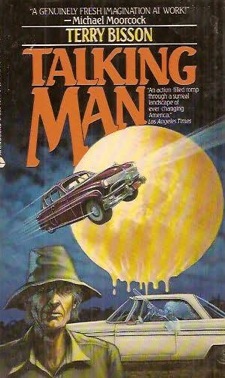Talking Man is one of the best fantasies ever.
Terry Bisson successfully does a thing here that few people even try, he makes the everyday fantastical not with folk magic but with high fantasy. This is a book in which a broken down car transmission is fixed with the blood of an antelope, and where there’s a city at one end of time called Edminidine and at the other a tower called Elennor. It’s written in a combination of folksy high fantastical language and you wouldn’t think it could work but it does.
This is not an urban fantasy. Indeed, it’s about as rural as fantasies get.
“Talking Man was a wizard who had a small junkyard on the side of a hill on the Kentucky Tennessee line. He sold parts and cars, swapped guns and cars, fixed farm machinery and cars, dug ginseng and mayapple in season, and had a 1,000 pound allotment of burley tobacco which he let his daughter raise… He looked anywhere between forty-five and sixty, but he was older than that. He was older than the hills. He was older than the words people used or the things they talked about with them, older than the ground he hunkered down on when he was making a trade, older than older than stone.”
As you can see, the writing is simultaneously poetic and folksy, and it’s all like that. It is both real and specific and close up as to place, and increasingly fantastical as it goes on. The characters quest across the mythical geography of America, across the north-flowing Mississippi, past the mountains of southern Illinois, across the great flat plains and past the great cliff of the Rockies rising on the side of the freeway. The land they come back into is even stranger, but just as American. The first time I read this, which seems to have been 1987, I missed a lot of this, because I didn’t have the knowledge of US geography to appreciate it properly. (I’m genuinely amazed it even got a British edition.) I recommend reading this on a long train ride (or road trip) across the US, because there never was a book so full of American landscapes and cars.
There’s a plot. There are characters—most especially there’s Talking Man’s daughter Crystal, and there’s Williams, who comes to Talking Man to try to mend the windscreen on his cousin’s Mustang, and then to understand how it got mended by magic, and gets drawn into the quest. There’s a world, that starts out as this world and gets weirder. There’s no telling whether the world is saved, really, and that’s one of the coolest things. Most fantasy is unambiguous in a very unmagical way. Talking Man is closer to actually feeling magical than most books—if somebody wanted to make a case that the text changed between readings, I’d be prepared to listen, because I certainly find different things in it every time I read it.
This is more like an epic poem than a novel, an epic poem in a Kentucky accent about driving to the imaginary lands of New Mexico and the North Pole, using a Mobil credit card and not being able to charge anything to it except gas, living on McDonalds and Snickers bars, with the radio cutting in and out, pursued and pursuing, on a road trip to save the world.
Jo Walton is a science fiction and fantasy writer. She’s published eight novels, most recently Half a Crown and Lifelode, and two poetry collections. She reads a lot, and blogs about it here regularly. She comes from Wales but lives in Montreal where the food and books are more varied.










